Because of the harsh environment we live in, Baker Nursery carries and grows many varieties of plants that have been developed specifically for the valley of the sun.
Copyright and trademark images and content provided for and owned by Arizona Wholesale Growers, Desert Tree Farm, Mountain States Wholesale Nursery, and Baker Nursery.
Palo Rojo Hybrid Palo Verde
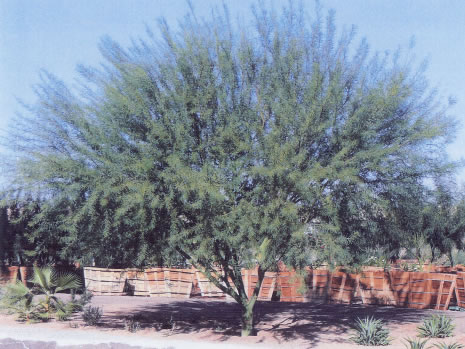
|
Just like its name suggests, the wood of the Palo Rojo morphs to hues of red and maroon as temperatures begin to drop in the fall.The Palo Rojo retains these striking colors in stark contrast to the bright green foliage. By May, the trunk and limbs return to a rich green color as the tree races back to a season of rapid growth. |
Sonoran Emerald Hybrid Palo Verde
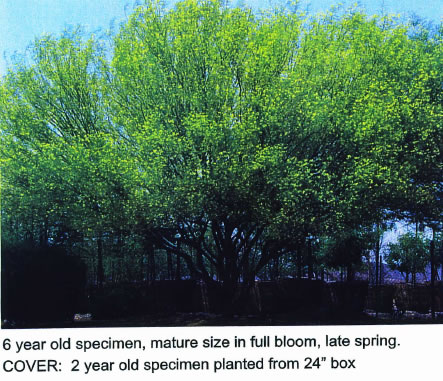
|
Like a sparkling jewel among the dusty
hues of the desert, Arizona Wholesale
Growers' Sonoran Emerald™ shines as nearly the perfect desert tree. Deep green in color, the Sonoran Emerald™ is lush and nearly evergreen with a spectacular flower display late May through June with sporadic flowering the rest of
summer. Extremely wind tolerant, the initial crop of trees gracefully withstood the windy monsoons of 1999.
Mature size 25'x25'
Semi-evergreen
Thornless
Non-fruiting
Yellow flowers late spring
Rapid growth
Xeriscape once established
Extreme Wind Tolerance
Cold Hardy to 18°F
|
Arizona Mesquite
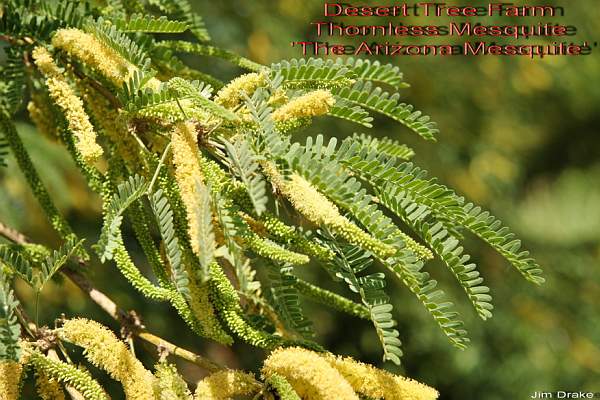
|
The 'Arizona Mesquite' tree is a thornless hybrid variety with deep green leaves and vigorous upright growth. With its medium size and lush umbrella shaped canopy, it has a high resistance to frost for extended periods of time.
| Sun |
full sun |
| bloom time |
no blooms |
| size |
30' tall x 30' wide |
| hardiness |
hardy to 15°F |
| Planting |
add organic soil when planting |
| water |
keep plants moist until established |
| Fertilize |
fertilize in early spring before new growth begins |
Pruning |
prune only to control size and shape |
|
Desert Son
|
Hesperaloe parviflora: Makes dense, yucca-like clumps of swordlike evergreen leaves. Bright yellow flowers offer a unique shrub that has tremendous drought tolerant qualities. Good large container plant with loose relaxed look.
| Sun |
full sun |
| bloom time |
Spring thru Summer |
| size |
3' tall x 3' wide |
| hardiness |
hardy to 15°F |
| Planting |
add organic soil when planting |
| water |
keep plants moist until established |
| Fertilize |
fertilize in early spring before new growth begins |
Pruning |
Remove old flowers to encourage new blooms |
|
Heavenly Cloud
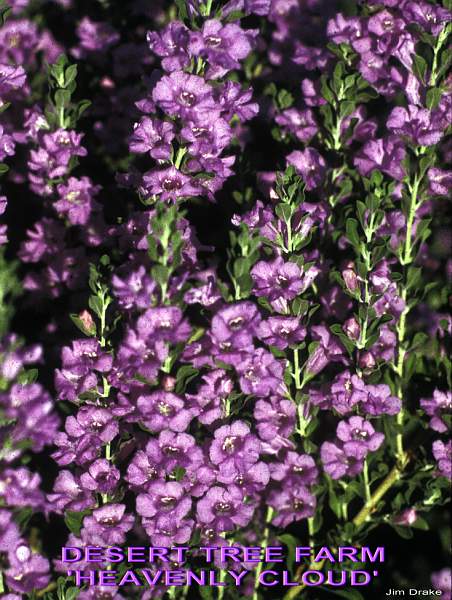
|
Popular slow-growing shrub produces lush violet flowers which appear occasionally during warm seasons, then profusely after a rain. Green foliage covers shrubby stems year round. Excellent low maintenance plant.
| Sun |
full sun |
| Bloom time |
summer through fall |
| Size |
5' tall x 5' wide |
| Hardiness |
hardy to 15°F |
| Planting |
add organic soil when planting |
| Water |
keep plants moist until established |
| Fertilizer |
fertilize in early spring before new growth begins |
| Pruning |
prune only to control size and shape |
|
Thornless Hybrid Palo Verde
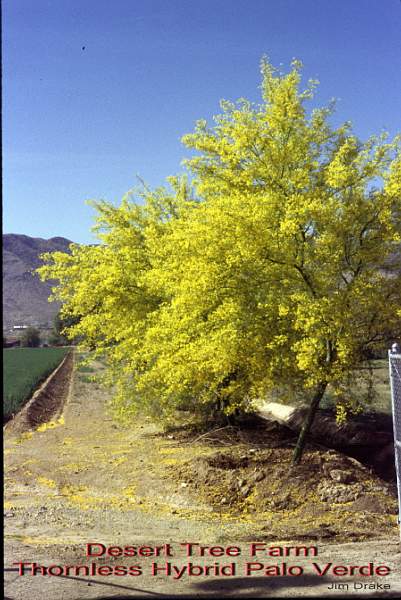
|
This semi-evergreen, thornless, Palo Verde hybrid exhibits qualities found in Palo
Brea, Blue and Mexican Palo Verde, provides ample shade, distinctive rich lush green trunks and intricate
branching pattern that, similar to the Palo Brea, remain smooth as they mature, and abundant brilliant yellow
flowers that appear in spring and intermittently during the summer months. The characteristics that set this hybrid apart from seed selections is the versatility to be grown as either a V-shaped upright or candelabra form
specimen. |
Phoenix Bird
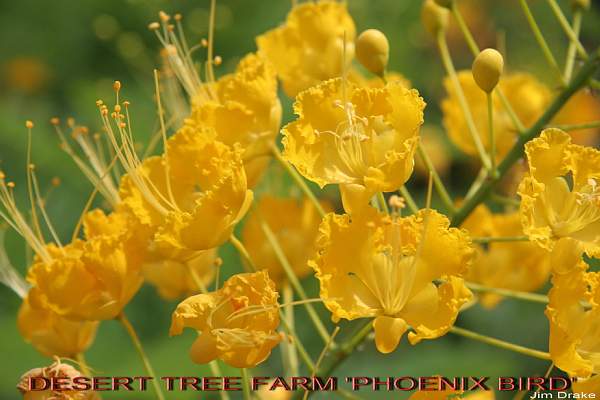
|
A spectacular yellow blooming deciduous shrub that blooms summer through fall. Excellent for a quick screen, although you may need to cut it back in spring, it will come back with lush green growth.
| Type |
Shrub |
| Sub Type |
Deciduous shrub |
| Description |
Phoenix Bird of Paradise |
| Height |
6' to 10' |
| Width |
6' to 10' |
| USDA Zones |
9 |
| Sun |
Reflected sun to partial sun |
| Hardiness |
20 to 30 F |
| Blooming Season |
June through November |
| Growth Rate |
Moderate to fast growth rate |
| Litter Rate |
Moderate litter rate |
| Water Usage |
Moderate water usage |
|
Maricopa Red
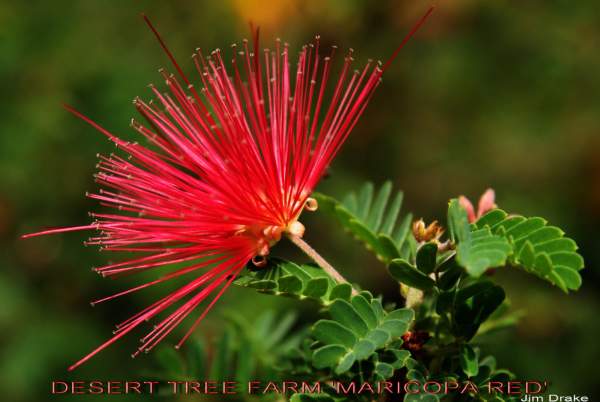
|
Graceful compact growth with showy red flowers make this an excellent shrub for any desert landscape. This hybrid will bloom under heat and drought conditions. Excellent plant for poor soil conditions.
| Sun |
full sun |
| Size |
3' tall 4-5' wide |
| Bloom time |
late winter to spring |
| Hardiness |
hardy to 25°F |
| Planting |
add organic soil when planting |
| Water |
Keep plants moist until established |
| Fertilize |
Fertilize in early spring before new growth begins |
| Pruning |
Remove old flowers to encourage new blooms |
|
Superstition Gold Bougainvillea
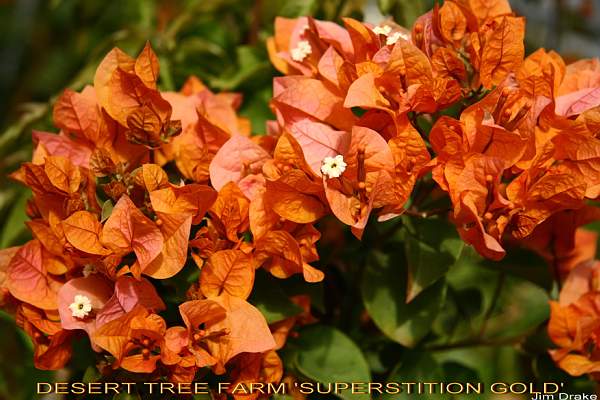
|
Vigorous, showy vine shines with rich golden blooms to give a fine cover to patios or arbors. Also a good ground cover for banks. Use as annual color in colder climates. Evergreen.
| Sun |
full sun |
| Size |
summer through fall |
| Bloom time |
15' tall x 15' wide |
| Hardiness |
hardy to 35°F |
| Planting |
add organic soil when planting |
| Water |
keep plants moist until established |
| Fertilize |
Fertilize in early spring before new growth begins |
| Pruning |
Prune only to control size and shape |
|
Trichocereus Hybrid
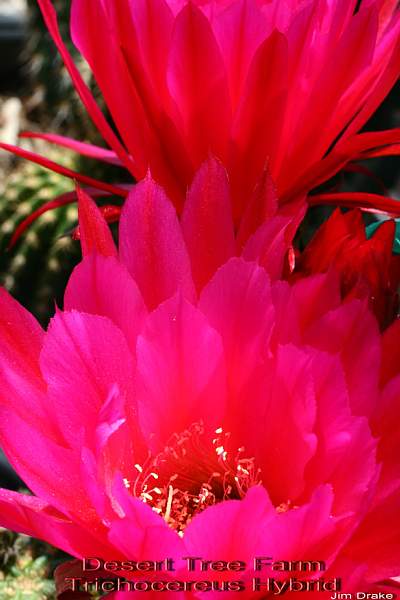
|
Information coming soon! |
Anisacanthus quad. Mexican Fire™
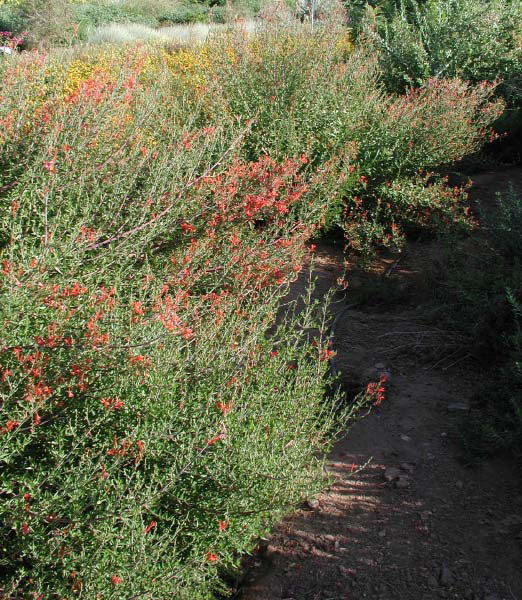
|
This medium-sized, deciduous shrub has a rounded to irregular shape. Its narrow, rich green leaves provide an effective backdrop for terminal spikes of tubular red-orange flowers. Flowers are produced early summer through fall and attract hummingbirds. This fast growing plant is quite drought tolerant, but flowers more profusely with summer irrigation. Cut back to the ground in late winter to encourage fresh spring growth and to control the size. Mexican Fire™ has deeper green foliage and more intensely red flowers than previous selections. |
Caesalpinia cacalaco Smoothie™
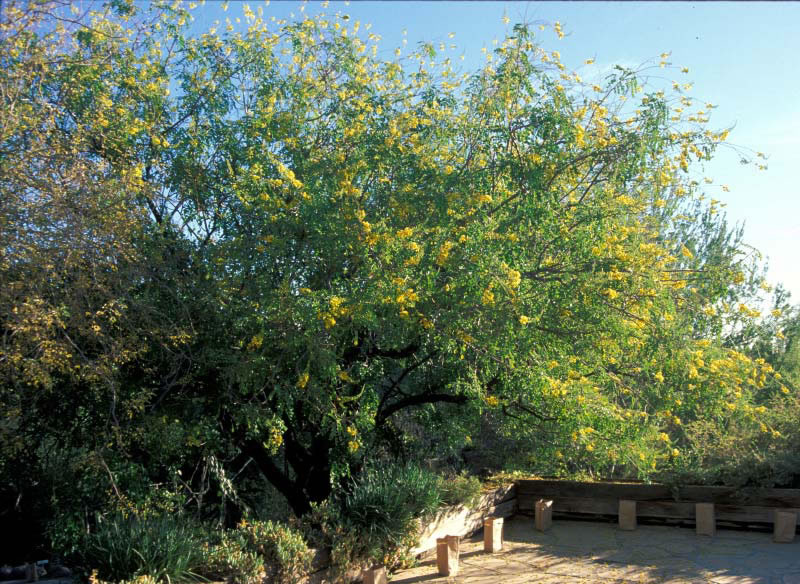
|
Cascalote is a great patio tree but the
thorns can be an issue. This thornless
introduction from Mountain States is
known as Smoothie™. It produces
the same large spikes of clear yellow
flowers at the branch tips during the
winter months, followed by attractive
copper-colored seedpods. Like its
parent, Smoothie™ may suffer frost
damage when temperatures drop below
20° F. In warm climates it will
remain evergreen, with glossy green
compound leaves. Smoothie™ Cascalote
grows best in full sun and
well-drained soil. |
Caesalpinia hybrid Sierra Sun™
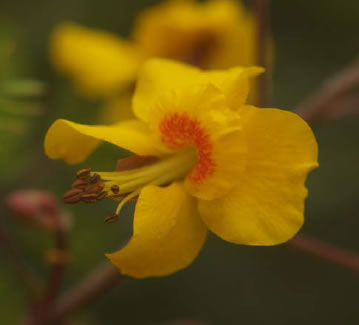
|
Caesalpinia hybrid Sierra Sun™ is a new
small-scale tree with lush green foliage and
an attractive vase-shaped form. Semi evergreen,
this small tree to large shrub has
verdant compound leaves that lend a
tropical feel to desert gardens. The distinctive
yellow flowers have an orange center.
Flowering may occur at any time during the
year but the heaviest bloom occurs from
fall to spring. The flower clusters are
followed by elongated seed pods. Sierra
Sun™ requires little pruning to maintain a
broadly oval shape making it a truly low
maintenance specimen. Plants can be kept
smaller if desired with occasional pruning.
Sierra Sun™ will drop its leaves at temperatures
below around 25° F. |
Chilopsis linearis Art's Seedless™
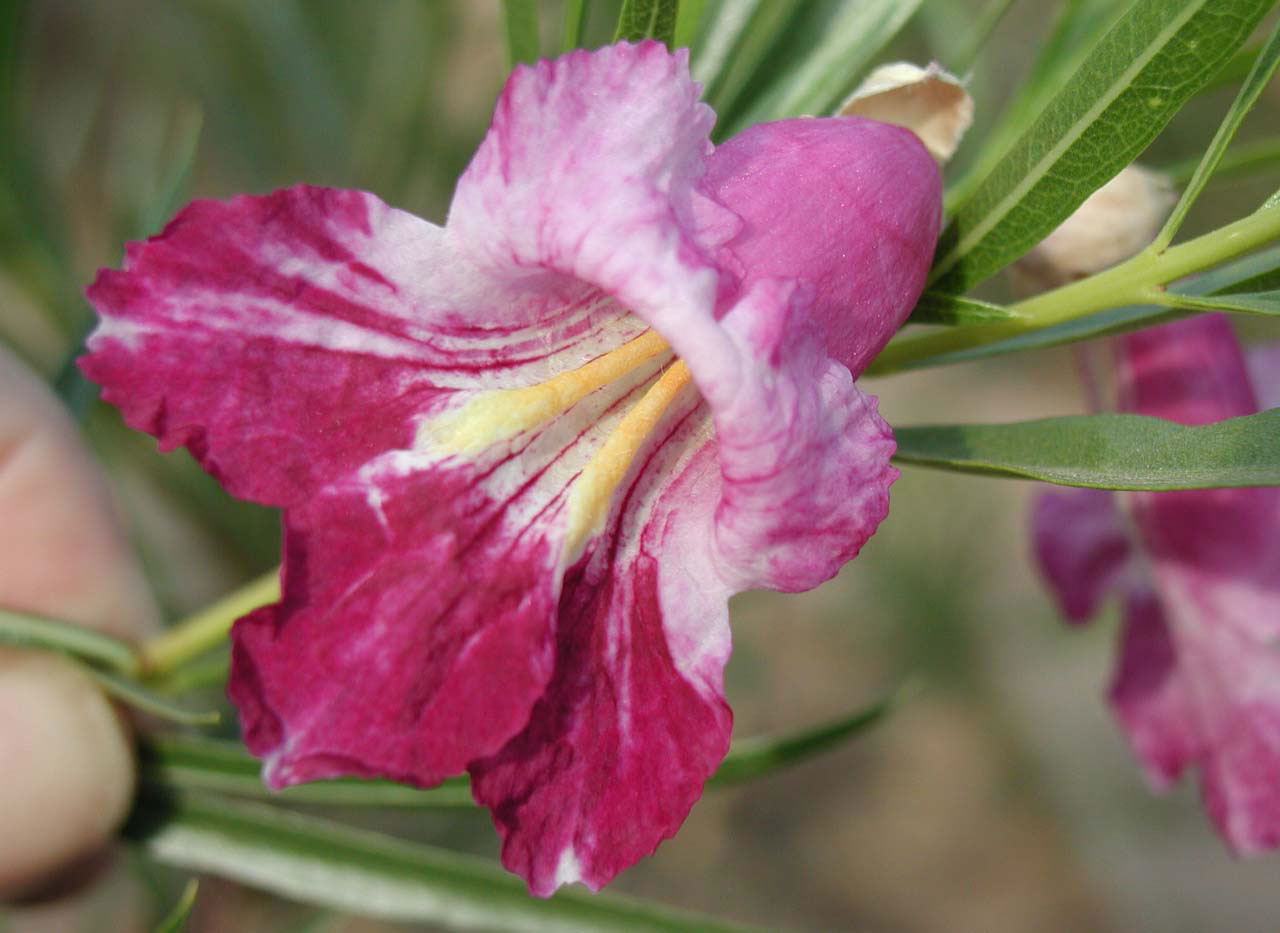
|
Desert willows have been popular in native
Southwestern landscapes for years. The large,
showy flowers produced during the heat of
summer provide months of color and attract
hummingbirds. Unfortunately, most desert
willows produce many long, narrow seed
pods which persist on the plant for months.
Art Combe, a famed plantsman known as the
Wizard of the Wasatch, created this seedless
form of desert willow. Art’s Seedless™ has
large, pink-rose flowers, long narrow bright
green leaves, but no messy seed pods. This
thornless, heat-tolerant, water-efficient tree
grows at a fairly rapid rate to about 25 feet
tall and wide. We are excited to offer this
long awaited introduction. Hardy to -10° F.
USDA Zone 6. |
Conoclinium greggii Boothill™
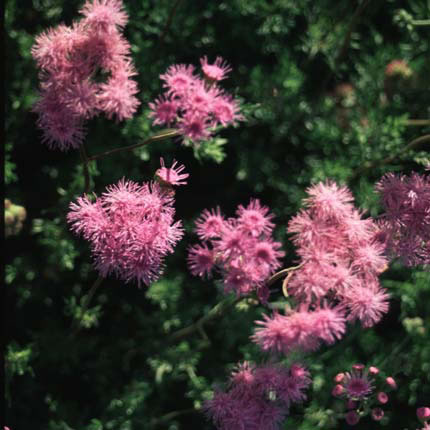
|
Eupatorium greggii Boothill ™ (Trademark by Mountain States Wholesale Nursery) is
a small, herbaceous perennial growing to about 2 feet tall and 2-3 feet wide. Its stems can either be strong
and upright, or weak and trailing along the ground, depending on the growing conditions. When grown
hard (not over watered or over fertilized) or when grown in full sun, the stems are stronger and more upright.
Its light green, fine-textured leaves resemble those of Verbena pulchella. Fuzzy lavender-blue
flowers occur in tight clusters at the ends of branches in the late spring, summer and fall. They are
excellent for attracting butterflies. Eupatorium greggii has rhizomes (underground stems), so even if it
burns back to the ground or is pruned back severely, it recovers readily. |
Eremophila maculata Valentine®
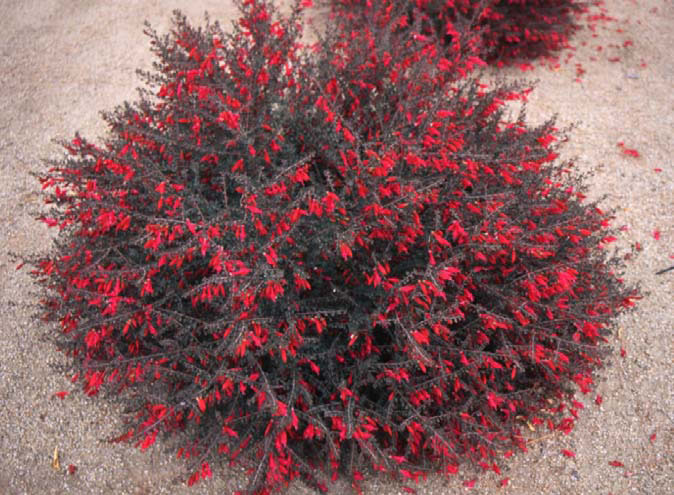
|
Eremophila maculata Valentine™ is a symmetrical evergreen shrub, with small
rounded green leaves. When plants are watered regularly, the foliage is lush and green. Several established
shrubs in a research plot which received only one irrigation last year had much smaller leaves with
a gray-green cast. In the winter, this shrub blooms on fresh young stems, which results in masses of tubular
red flowers along the tips of the branches. Also, the foliage is tinged with a reddish color in the winter
months. The foliage and growth habit are reminiscent of some Cotoneaster species. |
Eremophila x Summertime Blue™
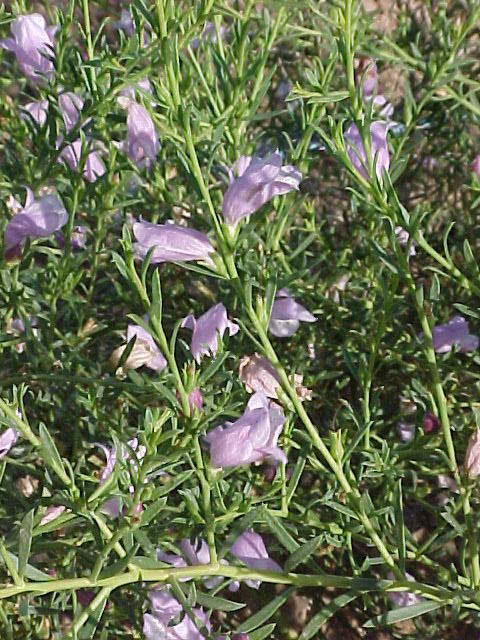
|
This particular selection came to us from
Down Under about a decade ago, and has been
a stellar performer in our trial garden. This
large, spreading evergreen shrub grows to
about 6 feet tall by 10 feet wide. The narrow
light green leaves occur on arching branches,
giving the shrub a fountain-like appearance.
Summertime Blue TM is sprinkled with tubular
lilac-blue flowers from spring till the end of
summer. Having originated from heavy soils
in its native land, this plant is well adapted to
the clay soils of the Southwest. Summertime
Blue™ is very drought-tolerant, and handles
full sun and reflected heat like a champ.
Hardy to frost and extended dry periods, this
gem will be a great addition to the line-up of
emu bushes. Hardy to 25°F. USDA Zone 9. |
Leucophyllum langmaniae 'Lynn's Legacy'
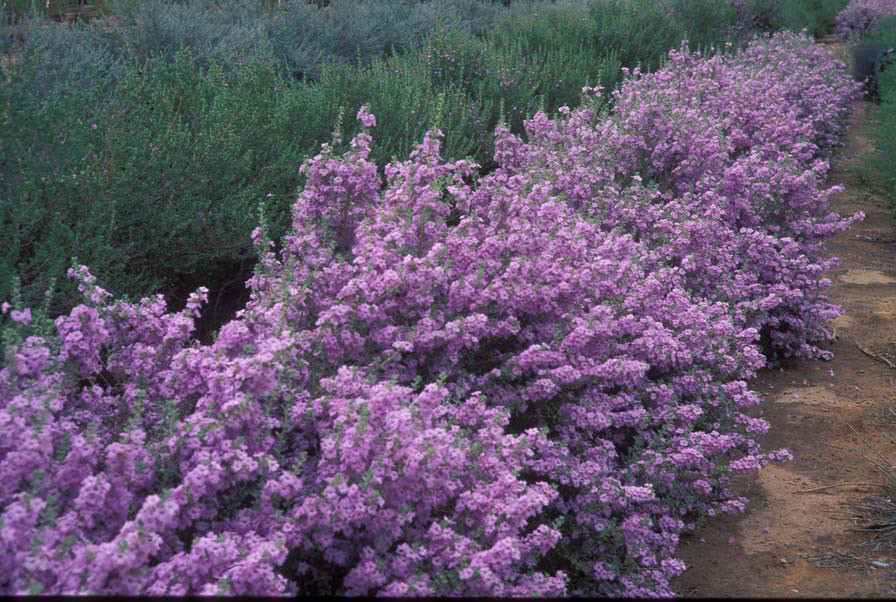
|
This selection of Texas sage was collected by
Lynn Lowrey, a very special plantsman from east
Texas. Lynn, who passed away in 1997, is a legend
among botanists and plant collectors. With his
usual discerning eye, Lynn picked out this clone
for its profuse and frequent flower displays. ‘Lynn’s Legacy’ grows slowly to about 5 feet tall
and wide, with a dense, rounded form. Its green
foliage is a wonderful backdrop for the lavender
flowers. Compared to most selections of Texas
sage, this clone is not as dependent on changes in
relative humidity for flowering. This means that
it blooms more often during the course of the
summer than other selections. In fact, this clone is
called ‘Lynn’s Everblooming’ in Texas. In many
ways, ‘Lynn’s Legacy’ is very similar to Rio
Bravo™, but grows more slowly and blooms
more frequently. Hardy to 10° F, USDA Zone 8. |
Leucophyllum pruinosum Sierra Bouquet™
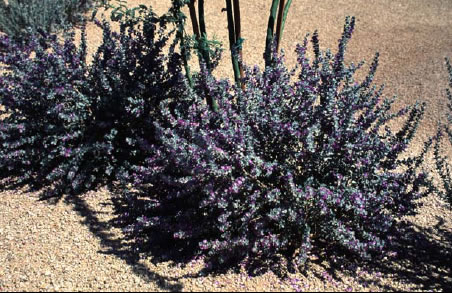
|
Leucophyllum pruinosum Sierra Bouquet ™ (Trademark name by Mountain States
Wholesale Nursery) is a medium to large shrub, growing to 6 feet tall and wide. It has an open, somewhat
sprawly growth habit. Its soft, velvety, grayish-white leaves are spoon-shaped and measure about 1/2 inch
long and 1/2 inch wide. The fragrant flowers are an iridescent blue-violet that you can almost see through.
The flowering season can begin as early as June and continues throughout the summer into the fall. |
Leucophyllum zygophyllum Cimarron ®
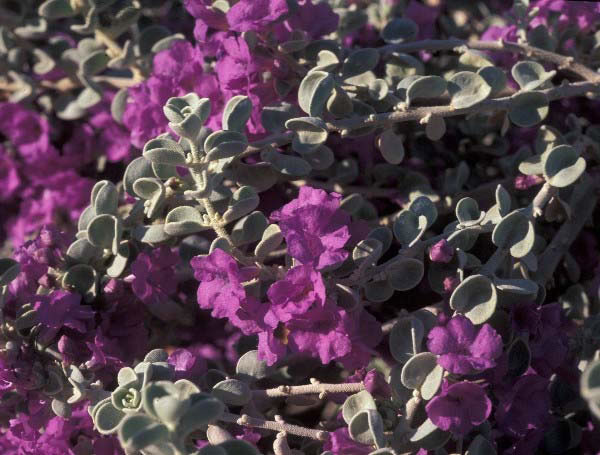
|
This petite evergreen shrub has a
soft, rounded form, with distinctively
cupped gray-green leaves. Masses of
blue-purple flowers are produced on
and off during the summer and fall
during periods of high humidity.
Cimarron® is one of the smaller
Texas sages, topping out at about 3
feet tall and wide. This species is
sometimes called Blue Ranger. It is
less likely to rot out than other
cultivars but do not over water and
provide well-drained soils to avoid
problems. |
Muhlenbergia capillaris Regal Mist®
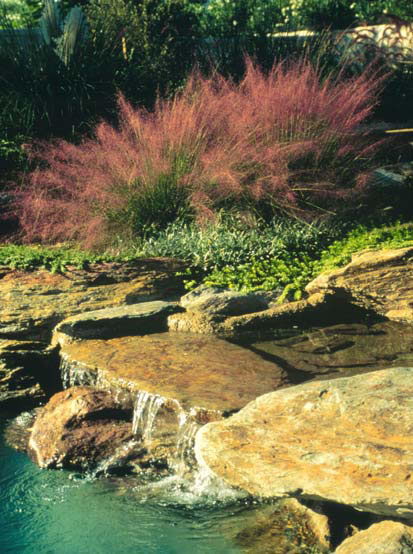
|
Regal Mist ™ is a clumping grass that grows to 3 feet tall and wide. The flowering
clusters add about 1 foot, giving the plant a height of 4 feet when in bloom. The narrow leaf blades are
a glossy dark green color, and grow to 1.5 inches long. Flower spikes are a deep pinkish-red color; with a
loose, open appearance that give the tops of the plants a feathery look. These flowering stalks appear in
fall and early winter, although bloom periods vary slightly with temperature. Plants in Tucson and Phoenix
start blooming in September and continue until November, with a peak in October. In cooler areas
like Albuquerque and Las Vegas plants start blooming a little earlier. |
Parthenocissus sp. Hacienda Creeper™
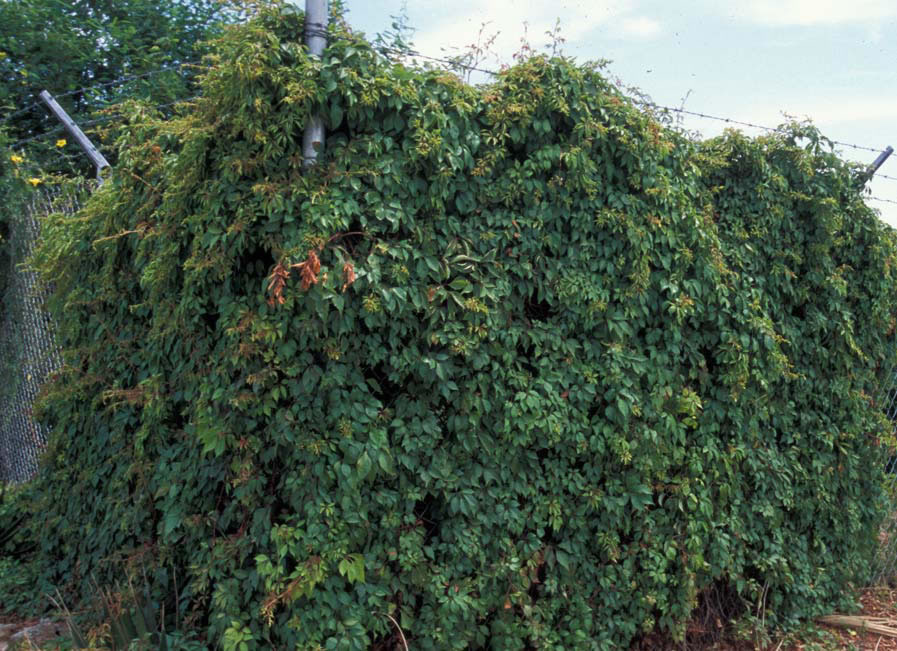
|
Hacienda Creeper™ resembles Virginia
Creeper, but is much smaller and slower growing.
This self-climbing, deciduous
vine has bright green palmate leaves.
With adequate fall chilling, the foliage
will turn a deep red color. It forms a
dense screen when grown on a chain link
fence, and is also suitable for use as a
groundcover or espalier. It is adapted to
full sun or part shade, poor soils and some
drought. Hardy to 0°F. USDA Zone 7. |
Poliomintha maderensis Lavender Spice™
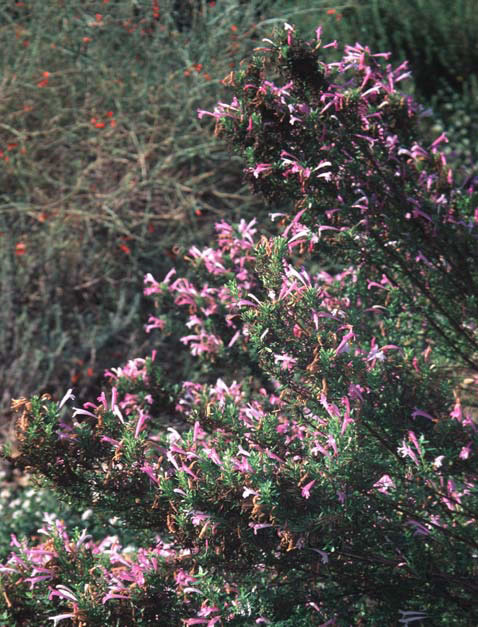
|
Poliomintha maderensis Lavender Spice ™ (trademark name by Mountain States
Wholesale Nursery) is a rounded shrub, growing to 3 feet tall and wide. The small, bright green leaves
have the delicious fragrance of oregano. The tubular lavender flowers measure just over 1 inch long.
These flowers are densely clustered together at the stem tips. Flowering starts in late April, continuing
through the summer and into the fall. Initially, flowers appear a few at a time, but by late May the shrub is
covered with them, and looks like a lavender ball until cooler weather hits. |
Prosopis glandulosa Maverick®
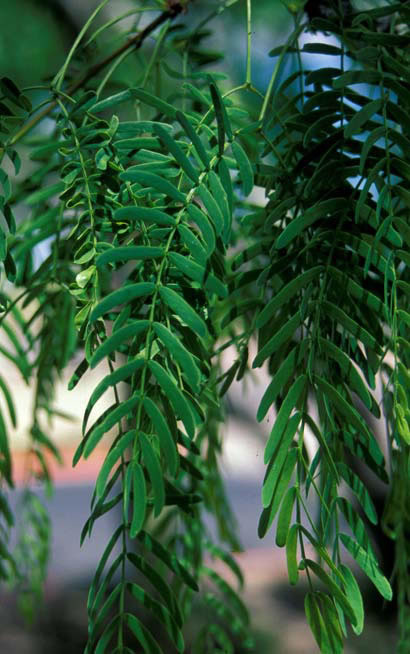
|
Maverick™ is a thornless selection of the
Texas honey mesquite, and is vegetatively
propagated to ensure this characteristic.
Prosopis glandulosa is the most reliably
cold-hardy mesquite, tolerating temperatures
down to 0° F. It has a wide spreading form to
about 30 feet tall by 30-35 feet wide. This
tree is best suited to parks or wide open areas
where it can spread out, as its natural growth
habit is rather open and irregular. (The
Prosopis hybrid Phoenix™ is a better choice
for narrower roadway and median plantings.)
The leaves are bright green, with widely spaced
leaflets. The leaves look very similar
to those of California Pepper (Schinus
molle). The smooth gray bark provides a
wonderful contrast to the green foliage. Texas
honey mesquite is completely deciduous.
USDA Zone 7. |
Prosopis hybrid Phoenix®
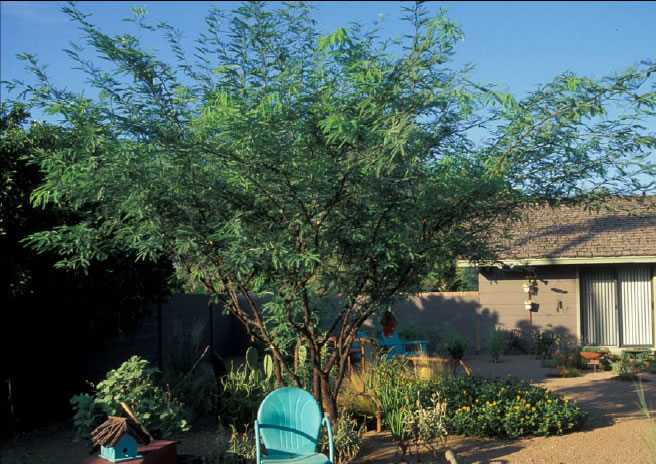
|
This grafted clone of South American Hybrid
Mesquite combines the lush, thornless,
uniform characteristics of Prosopis alba
Colorado™ with a reliable root system that
anchors the tree even in strong winds. In addition,
the Prosopis juliflora rootstock has
slowed down the top growth considerably,
and resulted in healthier branching structure.
To see examples of established specimens,
you are welcome to visit the nursery. We can
also direct you to other specimens in the area.
Prosopis hybrid Phoenix® will reach a mature
size of 30 feet tall and wide. In low
deserts it is semi-evergreen, with lush green
compound leaves. It is reliably cold hardy to
15° F. These trees are either multi-trunked or
low-breaking, but a good percentage have the
narrow vase shape required for parking lots
and other narrow planting spaces. USDA
Zone 8. |
Salvia greggii Sierra Linda™
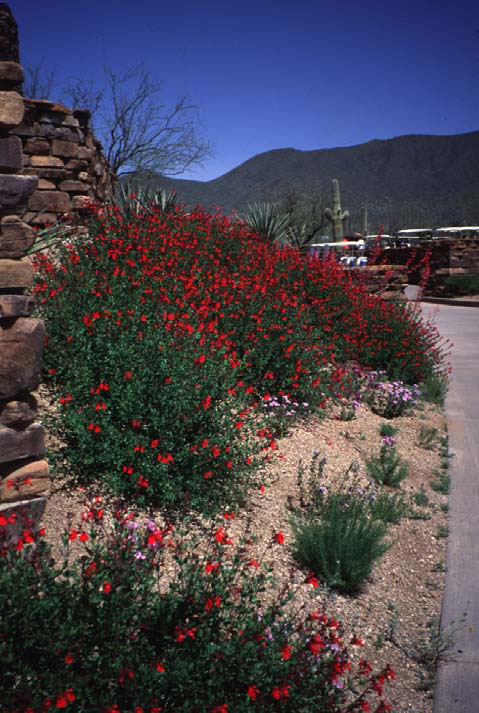
|
This clone of autumn sage was our attempt to select a plant with more heat tolerance. While it handles the Phoenix summers better than any other selection we have found, it still requires some protection from intense afternoon sun. It works well on east exposures, and can even handle full shade, although flower production will be limited. In the spring and fall this small 3-foot shrub blooms profusely with small hot pink flowers, attracting hummingbirds and humans alike. The small, glossy, dark green leaves of this plant make it a nice addition to the oasis zone of a garden. Pruning off old flower spikes enhances blooming, and nitrogen fertilization helps to carry plants through the summer heat. It is hardy to 0º F. USDA Zone 7.
|
Tecoma hybrid Sierra Apricot™
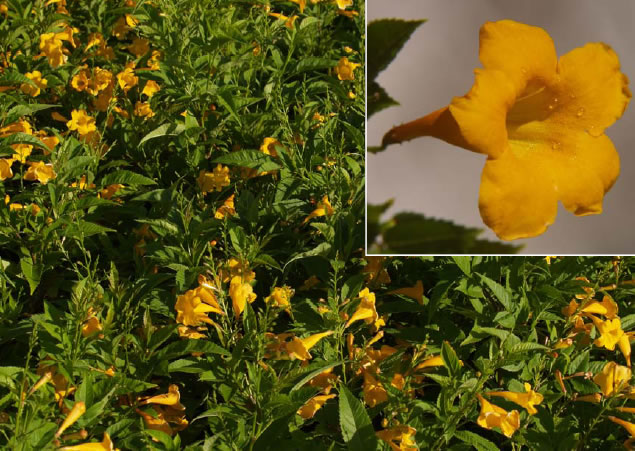
|
This petite new Esperanza from Mountain
States delivers a powerful punch of apricot
color in the summer months. This garden
gem is smaller than previous selections,
with a compact and dense form. Because it
is virtually seed free, this clone blooms
continuously throughout the summer
months with large clusters of bell-shaped
flowers. Hummingbirds love the tubular
blossoms! In mild climates Sierra
Apricot™ remains mostly evergreen, but
is deciduous below temperatures of 25°F.
Simply cut the stems back after frost, and
plants will flush out quickly in the late
spring. |
Tecoma x Sunrise™
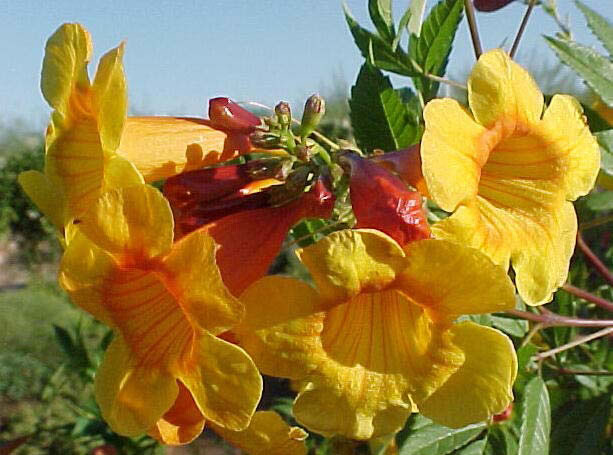
|
This Mountain States selection has a
lengthy bloom period, producing glorious
spikes of orange-yellow flowers from
spring to fall. Sunrise™ has a burnished
copper color on the flower buds and the
back of the inflorescence. This plant has a
clean habit, as it drops old, spent flowers
quickly. It doesn’t set seed until late in
the season, which means a constant
supply of new blossoms during the
summer. Hummingbirds are drawn to the
tubular flowers. It is considered slightly
hardier than ‘Gold Star’, but if frost
damage should occur, cut the plant back
in early spring to rejuvenate growth. In
warmer regions, the plant may reach 8
feet tall and wide. USDA Zone 9. |
Zephyranthes x 'Prairie Sunset'
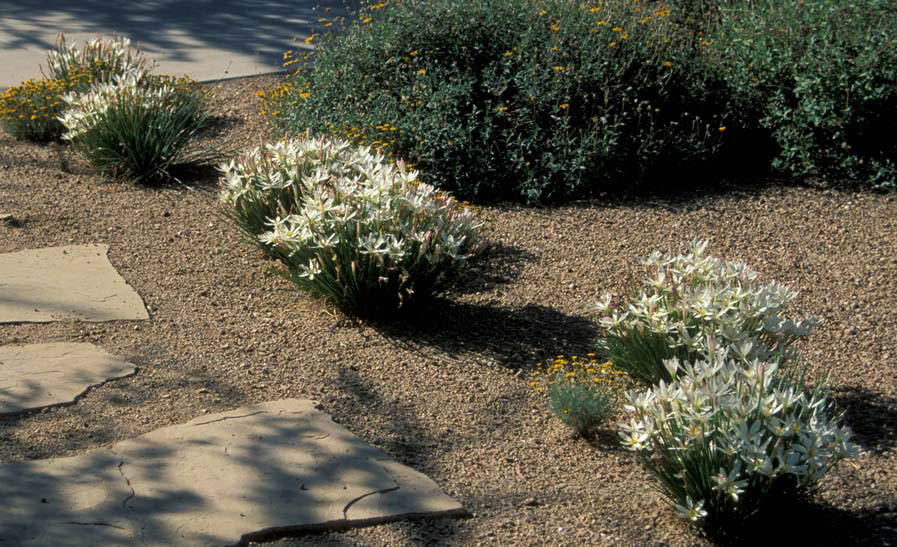
|
A hybrid of Zephyranthes x 'Capricorn' and Zephyranthes candida it distinguished by its tufts of foliage. In August, it thrusts out pale-apricot flowers that fade to pale pink. This plant loves to be pot bound. 12" tall by 15" wide. Hardy to 10 °F. USDA Zone 8. |
Popcorn Cassia
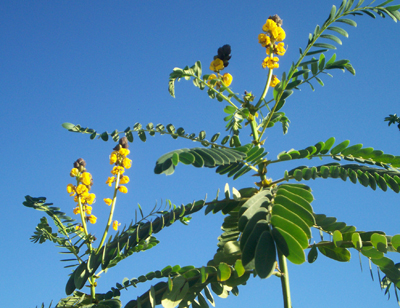
|
Fast growing, gorgeous foliage, luscious black buds & showy bright yellow flowers make this native legume of east Africa a valuable garden accent. To 8’ tall, multi-branching with beautiful tropical looking, bright green, pinnate foliage, this unusual Cassia blooms Spring through Fall but most heavily in Summer & Fall. The showy 2” flowers are densely held on branching spikes up to 1’ long & emerge from rich, shiny black buds. Can get rangy, so prune back after flowering to maintain a pleasing shape or can be trained as an interesting vine subject. Foliage has a rich buttered popcorn scent! |
Scarlet Wisteria
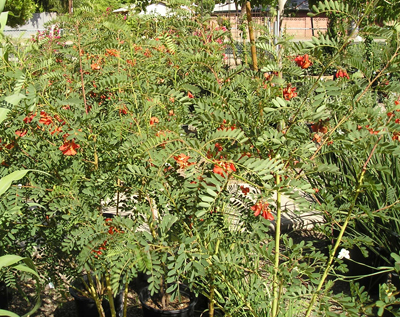
|
The scarlet wisteria tree grows to about four meters in height. The compound leaves are evenly pinnate (no end leaflet). The flowers are a brilliant orangey-scarlet and borne on drooping racemes. The seedpods have four 'wings'. When mature, the seeds loosen and rattle within the pod. (This trait is totally unnerving to field personnel who are expecting to come upon rattlesnakes.) |





























